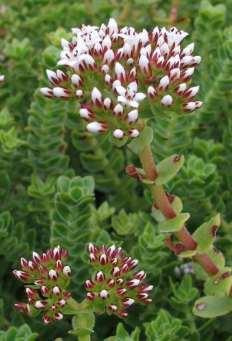Crassula dejecta
 Image: richardadcock
Image: richardadcock
Description
Crassula dejecta has decorative, fresh green foliage and showy white summer flowers, a good ground cover for the water-wise garden and a rewarding potplant.Crassulas are easy to grow and Crassula dejecta is no exception. It does best when planted in well-drained soil, and fed with well-rotted compost and frequent low doses of organic fertilizer. Do not over-water. It does well in sun, or semi-shade and can be grown in a position that is light, as in open to the sky, but may only get direct sun for a short part of the day e.g. on the south or southwest side of the house. It makes an excellent water-wise groundcover if planted en masse. It forms a neat little bush that looks good on the edge or near the front of borders and in mixed plantings, and is perfect for the water-wise garden, fynbos garden, and in rockeries. It also makes an attractive container plant and can be grown on the windowsill or indoors where it gets bright light.
In Crassula the stomata are closed during the day but open at night so that when they take in the CO2 they lose the least amount of water. The CO2 taken in at night is stored in the form of organic crassulacean acids. During the day, these acids are broken down and the CO2 is released and re-used in the photosynthetic process.
In this way they lose much less water yet can photosynthesize normally during the daylight hours. Furthermore, during extremely dry periods they won't even open their stomata at night, and will recycle the CO2 within the cells. They won't be able to grow at all but the cells will be kept healthy, a process known as CAM-idling.
Propagation instructions - cuttings
Cuttings can be taken at any time of the year and they root easily without the need for misting, bottom heat or even rooting hormones. They can be rooted in a well-drained medium in a cold-frame, or planted directly where they are intended to grow - in the Cape this is best done during autumn.
Propagation instructions - seeds
Crassula dejecta is easily propagated by seed or cuttings. Being a plant from the winter rainfall region, seed is best sown in autumn, but it will germinate if sown in spring or early summer. Sow on the surface of a well-drained, sterile medium or sprinkle seed with clean coarse sand in a thin layer on the surface of the sowing medium. Keep moist and well ventilated.
Sources and references
Scientific name
Crassula dejecta
Common name(s)
doily crassula
